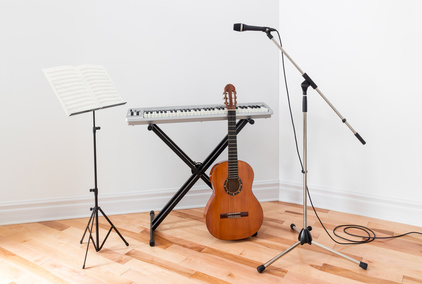Do you want to become a better singer, but you’re not sure how or what to practice to improve? A lot of my students come in for a first lesson with these questions- “How do I practice?”, “What do I practice?”, “How much do I need to practice?”
I’ve laid out a detailed practice guide that will teach you how to practice singing.
Studying singing is just like studying any other instrument. Practice is essential for improvement. Some of the essential skills needed for good singing are rhythm, pitch, tone quality and breath control. We practice and develop these skills through song study, vocal exercises, breathing exercises and ear training. You should focus on any areas of weakness.
What Does a Typical Practice Session Look Like?
You should practice singing at least 4 days a week for 30-60min a day. You need to build good singing habits and muscle memory, so consistent practice is key. Singing full voice for more than an hour a day can be fatiguing, especially when you are just getting started.
Have a private spot set up for practice- ideally in front of a piano. Somewhere where you can focus and feel free to sing without inhibitions. Keep some warm water with honey & lemon on hand.
1.) 5-10 min– Start with some light vocal warm-ups- humming, lip trills, slides
2.)10-20 min– Breathing exercises, vocal exercises and/or ear training exercises to train the breathing muscles, vocal folds and ears. Spend most of your time on the skills that need the most work. (See links below for breathing, vocal and ear training exercises)
3.)15-30 min– Song study. Practice songs that you love to sing and that are within your vocal range and abilities. It’s key to apply the techniques that you are learning and developing to these songs.
How To Practice Singing- Rhythm Exercises
Do you have a hard time keeping time? Is it tricky for you to sing along with a karaoke track and know where your entrances are?
1.)Rhythm exercises can be found in many sight singing books. My favorite is Sight Singing- The Complete Method for Singers . This book is great for beginners as well as more experienced singers.
2.)One simple exercise I have my students do is keeping time by clapping, snapping or tapping as you listen to your favorite songs. The first step is being able to find the beat and stay with it.
3.)Looking at the sheet music as you sing can be a good way to develop your rhythm. You can see the notes as they pass and keep track of the beats in each measure.
How To Practice Singing- Pitch Exercises
Do you sometimes feel like you are singing out of tune? Is it hard for you to stay in tune when you are singing by yourself (and not along with a recording)?
1.)Ear training is the best way to improve your pitch. Check out these helpful ear training exercises-
How To Sing And Play The Major Scale
Train Your Ear With Solfege Syllables
2.)Practicing vocal exercises is also a great way to develop better intonation. Check out these vocal exercises and practice them on a daily basis-
5 Easy Vocal Warm-ups for Singers
2 Challenging Vocal Exercises for Singers
3.)Learning some piano basics is a fantastic way to learn to sing more in tune. With some basic piano skills you can play ear training exercises and melodies for yourself. Singing along with the piano is one of the best ways develop a better ear quickly.
Piano Keys- A Simple Guide To Learning Notes on the Piano
How To Read Music- Treble and Bass Clef Notes
Not sure if you are singing in tune or not? 1.)Record yourself and listen back 2.)Ask someone who is a good singer to listen to you 3.) Schedule a voice lesson and ask a professional!
How To Practice Singing- Tone Quality Exercises
Remember that singer, William Hung, famous for his strange American Idol audition? (Here’s a video to refresh your memory- https://www.youtube.com/watch?v=0d5eP0wWLQY)
William is actually singing in tune and with pretty good time. What makes his singing voice unpleasant is his tone quality. The actual sound of his voice. He sounds like he’s speaking a little more than singing. His phrases are not fluid and musical. William Hung is actually not a bad singer, he just needs a little help 🙂
1.) Tone quality is directly connected to breath. If you don’t have enough air flow, the tone quality will be breathy or thin. It can even be a harsh, strangled sound if that throat is tight and restricted. Try singing one, long held note. Take a deep, low breath, keep your throat relaxed and sing. Feel your vocal folds vibrate and resonate as you sing. The more open resonance there is in your body, the richer and fuller your tone will be.
2.) Tone quality also has to do with placement. Where is the airflow directed and where is the sound resonating? In your chest? Your head? Your sinuses? For example, if you have been told that your tone is too “nasally”, this means that the sound is resonating too much in your sinuses. Try opening and rounding the shape of your mouth to warm up your tone and change where the sound is focused. Try this exercise to experiment with different tone qualities you can produce with your voice-
Tone Quality Exercise
How To Practice Singing- Breath Control Exercises
Do you run out of breath really fast when you are singing? Do you have trouble hitting high notes? Does your throat get tight or tired when you sing?
1.)Singers are wind instruments- we need a steady stream of air to make a good sound. Check out these tutorials and breathing exercises to master deep breathing-
Breathing Technique for Singing
3 Easy Breathing Exercises for Singing
Singing Exercises for Better Breath Control
If you have any questions, just write them in the comments section and I will reply! Enjoy your practice!






1 Comment
herm stillman
July 6, 2016Thanks for all your advice and help!
Leave A Response